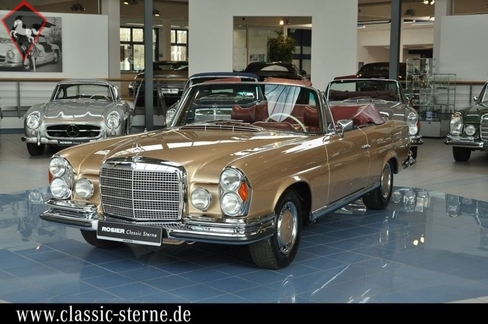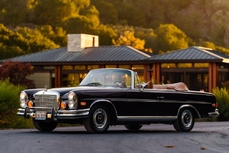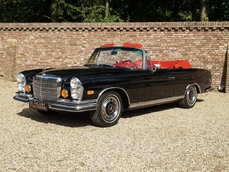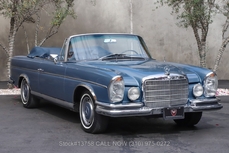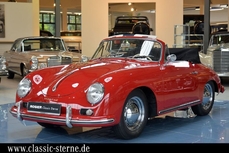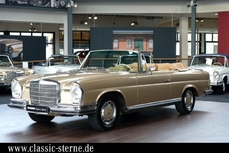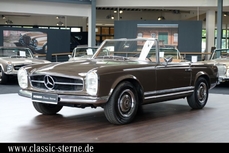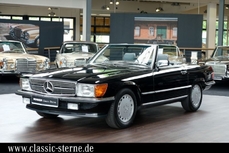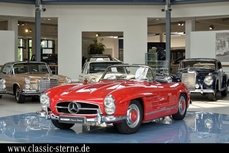Mercedes-Benz 280SE Cabriolet w111 SE 3.5 Cabriolet W111 Prominenter Vorbesitz 1971
General description :
Interne Fahrzeugnr.: 20186
Ansprechpartner: Gross, Dietrich - 0441 209780 12
José Antonio Girón de Velasco auch genannt „ der Löwe von Fuengirola“ war Minister in der Diktatur von General Francisco Franco in Spanien und galt als sehr vermögend. Er wollte seinem Status entsprechend ein luxuriöses Mercedes Cabriolet besitzen und orderte über die Mercedes-Benz Vertriebsorganisation in Spanien im Dezember 1970 dieses elegante, in sandbeige-metallic lackierte 280SE 3.5 Cabriolet. Gleich im Januar 1971 wurde der Wagen zugelassen und an seinen neuen Besitzer ausgeliefert. Er nutzte den Wagen in seinem privaten Bereich die nächsten Jahre und behielt ihn auch, als 1975 die Diktatur von General Franco zu Ende ging. Ende der 1980er Jahre ging der Wagen in den Besitz von Belen Ramirez Rivera Schreiber, einer angesehenen Dame aus Madrid, die den Wagen hauptsächlich im sonnigen Andalusien, im Raum Malaga nutzte. Zu Beginn der 2000er Jahre ging das Cabriolet in den Besitz von Bertran Garcia Braulio, einem Autohändler und Immobilienkaufmann in Barcelona über. Während seinem Besitz wurde in 2003 von Mercedes Benz Classic ein Zertifikat ausgestellt. In 2013 wurde das bis dahin stets gepflegte und in sehr gutem Zustand erhaltende Cabriolet nach Deutschland verkauft und kam zu Rosier Classic Sterne in Oldenburg. Der hohe Qualitätsanspruch unserer Kundenklientel ließ uns die Entscheidung zugunsten einer umfangreichen Restaurierung fällen. So wurde das elegante Cabriolet komplett zerlegt, bis auf das blanke Metall entlackt und neu aufgebaut. Selbstverständlich wurde darauf geachtet, die ursprüngliche Farbgebung wieder zu verwenden und die Ausstattungsdetails gemäß Datenblatt wieder herzustellen. Sogar das originale, fein patinierte Leder konnte erhalten werden. Lassen Sie sich dieses herrlich schöne Fahrzeug mit bester Historie nicht entgehen. Wir beraten Sie gerne.
José Antonio Girón de Velasco, also known as “the lion of Fuengirola“ was minister in the dictatorship of General Francisco Franco in Spain and was considered as quite wealthy. Corresponding to his status, he wanted to have a luxurious Mercedes-Benz convertible and therefore ordered this elegant, sandbeige metallic 280 SE 3.5 Cabriolet with the Spanish sales organisation of Mercedes-Benz.
Für weitere Detailinformationen zu diesem Fahrzeug oder Interesse an einem Besichtigungstermin kontaktieren Sie unser Verkaufsteam Dietrich Gross 0441-209780-12 oder Daniel Krzykowski 0441-209780- 11.Unseren aktuellen Fahrzeugbestand finden Sie unter http://www.classic-sterne.de
Zubehörangaben ohne Gewähr, Änderungen, Zwischenverkauf und Irrtümer vorbehalten!
powered by two S
1971 Mercedes-Benz 280SE Cabriolet w111 SE 3.5 Cabriolet W111 Prominenter Vorbesitz is listed for sale on ClassicDigest in Bremer Heerstraße 267DE-26135 Oldenburg by Rosier Classic Sterne GmbH for €425000.
Car Facts
Car type : Car Make : Mercedes-Benz Model : 280SE Cabriolet w111 Model Version : SE 3.5 Cabriolet W111 Prominenter Vorbesitz Engine size : 3.5 Model Year : 1971 Sub type : Convertible Location : Bremer Heerstraße 267DE-26135 Oldenburg Vehicle Registration : Undefined
425000 €
Seller Information
Rosier Classic Sterne GmbH
Rosier Classic Sterne GmbH
+49 (0)441 2492813813
Rosier Classic Sterne GmbH
+49 (0)441 2492813813
People who viewed this Mercedes-Benz 280SE Cabriolet w111 also viewed similar Mercedes-Benz listed at ClassicDigest
Other cars listed for sale by this dealer
About Mercedes-Benz
In the annals of automotive history, the journey of Mercedes-Benz is a tale that unfolds with the ingenuity of its founding pioneers. In the year 1886, Karl Benz crafted the Benz Patent Motorwagen, a creation that would go down in history as the world's inaugural automobile. Unbeknownst to him, this moment marked the genesis of what would evolve into the most illustrious premium car manufacturer globally. The financial underpinning of this pioneering venture, interestingly, was provided by Karl Benz's wife, Bertha Benz, demonstrating a remarkable partnership that would set the tone for Mercedes-Benz's legacy.A parallel narrative emerged not far away, as Daimler-Motoren-Gesellschaft, founded by Gottlieb Daimler and Wilhelm Maybach, entered the scene. In 1901, they unveiled their automobile under the now-famous moniker "Mercedes," meaning "godsend" in Spanish. This name was bestowed upon the car at the behest of Emil Jellinek's daughter, the distributor for Daimler-Motoren-Gesellschaft. The wheels of innovation were set in motion.
Fast forward to 1926, a pivotal year that witnessed the merger of Daimler with Benz & Cie., culminating in the birth of Daimler-Benz. The amalgamation saw the adoption of "Mercedes-Benz" as the distinguished trademark for their automobiles, fusing the legacies of two visionary entities into one.
Contrary to perceptions of conservatism, the trajectory of Daimler-Benz unfolds as a chronicle of industry firsts. From the introduction of the honeycomb radiator to the float carburetor, and the pioneering implementation of four-wheel brakes in 1924, Daimler-Benz consistently pushed the boundaries of automotive innovation. The diesel-powered Mercedes-Benz 260 D in 1936 marked the inception of diesel engines in passenger cars. The iconic Mercedes-Benz 300SL Gullwing made history as the first car with direct fuel injection, albeit the Gutbrod's tiny 2-stroke engine can claim precedence.
Safety innovations became a hallmark, with Béla Barényi's patented safety cell design in the "Ponton"-models in 1951, featuring front and rear crumple zones. The W116 450SEL 6.9 saw the introduction of the Anti-Lock Brake system (ABS), another pioneering safety feature. From the first production airbags and beyond, the legacy of "firsts" continued to be etched into the fabric of Daimler-Benz.
Over its centennial journey, Mercedes-Benz has not merely produced cars but has sculpted automotive icons. The SSKL, 710 SSK Trossi Roadster, 770K Grosser, 540K Spezial Roadster, 300SL Gullwing, w100 600 Pullman, w111 280SE 3.5 Flachkühler, w113 230SL Pagoda, w109 300 SEL 6.3, and w201 2.3-16 Cosworth stand testament to the brand's commitment to engineering excellence.
The roaring Silver Arrows, or "Silberpfeile," including the W 25, W 125, W154, W165, and W196, created a legacy of dominance on the racetrack. These machines were not merely cars; they were expressions of precision, speed, and an indomitable spirit that left their competitors in the dust.
As Mercedes-Benz marches into the future, it does so not just as an automaker but as a custodian of a legacy, a torchbearer of innovation, and a beacon of automotive excellence. The road ahead is sure to witness the continued fusion of cutting-edge technology, timeless design, and an unwavering commitment to setting new standards in the world of automobiles.
One luminary figure who left an indelible mark was Béla Barényi, often heralded as the "father of passive safety" for his pioneering work in safety engineering. His patented safety cell design, featuring front and rear crumple zones, became a hallmark of Mercedes-Benz's commitment to occupant safety, setting new standards that reverberated throughout the automotive world.
Moving through the chronicles, the collaborative genius of Wilhelm Maybach, alongside Gottlieb Daimler, laid the foundation for Daimler-Motoren-Gesellschaft. Their innovations not only birthed the first Mercedes but established a culture of relentless pursuit of technological excellence that remains integral to Mercedes-Benz's DNA.
In the post-merger era of 1926, Ferdinand Porsche emerged as a prominent figure within Mercedes-Benz. His work on the Mercedes-Benz S-Type, a supercharged race car, garnered acclaim and set the stage for a legacy that extended far beyond the marque. Porsche's impact would later extend to his eponymous company, but his influence at Mercedes-Benz during those formative years was pivotal.
As the 20th century progressed, the legendary Rudolf Uhlenhaut emerged as a key figure. Uhlenhaut, an accomplished engineer and the driving force behind the iconic Silver Arrows, played a crucial role in Mercedes-Benz's dominance in motorsports. His engineering prowess and attention to detail were instrumental in creating some of the most formidable racing cars of the era.
In the latter half of the century, figures like Bruno Sacco, the head of design at Mercedes-Benz from 1975 to 1999, left an indelible imprint on the brand's aesthetic identity. Sacco's design philosophy, characterized by clean lines and timeless elegance, shaped iconic models like the W126 S-Class and the W201 190E, solidifying Mercedes-Benz's reputation for luxury and sophistication.
The narrative would be incomplete without acknowledging the contributions of engineers like Hans Scherenberg, whose leadership in the 1970s ushered in a new era of technological innovation at Mercedes-Benz. Scherenberg's tenure saw the development of groundbreaking technologies, including the Anti-Lock Brake system (ABS) and the introduction of airbags in production cars.
